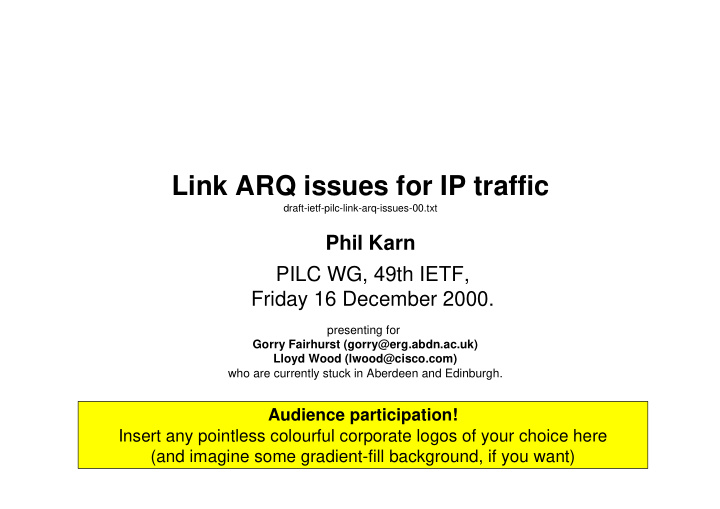



Link ARQ issues for IP traffic draft-ietf-pilc-link-arq-issues-00.txt Phil Karn PILC WG, 49th IETF, Friday 16 December 2000. presenting for Gorry Fairhurst (gorry@erg.abdn.ac.uk) Lloyd Wood (lwood@cisco.com) who are currently stuck in Aberdeen and Edinburgh. Audience participation! Insert any pointless colourful corporate logos of your choice here (and imagine some gradient-fill background, if you want) PILC - link ARQ issues for IP traffic 1
Motivation of draft Advice to Internet subnet designers draft doesn’t discuss ARQ persistence issues for serial links. Aim was simply to provide some text for Advice draft; by writing arguments down, we came up with this draft. Focus of draft ARQ retransmission persistency: ‘How long a link is permitted to delay an IP packet, in an attempt to retransmit it reliably’. Short summary Low ARQ persistence is the lesser of two evils when you can’t safely separate IP traffic into classes. PILC - link ARQ issues for IP traffic 2
ARQ options • perfect persistence - not recommended. • high persistence - may be suitable, but has pitfalls; needs a smart sliding-window ARQ implementation. • low persistence - always a safe bet for IP traffic; especially if you can’t differentiate between flows. Ordering • preserving ordering is desirable, but not at the expense of blocking other traffic or leading to packet/frame drops by the link. • ideally identify flows and preserve ordering within individual flows. • needs clear information from IP layer ( flow id ideal). Important You need to consider impact on the current flow and the impact on other flows also sharing the link. PILC - link ARQ issues for IP traffic 3
Separating traffic into different flows What it is isn’t what it does • peeking at transport headers and port no. tuples to identify flows may be a quick and tempting fix. Assumptions about traffic requirements • links guessing what flows do/want is questionable. Traffic changes over time e.g. contrast TCP use before/after web became popular: How would that affect TCP performance across a persistent ARQ scheme designed for TCP use pre-HTTP? IPSec can make peeking impossible. Tunnelling can make peeking harder - especially when tunnels aggregate flows! PILC - link ARQ issues for IP traffic 4
Practical links vary in complexity Real-world examples complicate analysis: • more elaborate ARQ procedures e.g. hybrid/adaptive ARQ. • vulnerabilities to particular patterns of loss caused by interference/noise. • MAC persistency with resource allocation in the mix. • the need to support link CoS / QoS… We can’t prescribe for or describe all of these - so we don’t even try.
…but we hope that: …we show clearly what IP does in the face of ARQ. …laying out ARQ issues well provides insight into effects on IP for future link designers - even designers faced with real-world complexity and things we don’t consider. We don’t aim to categorise ARQ definitively, just to make people aware of what it can do to IP traffic. Low-persistency link ARQ is safe and desirable Higher persistency may have added benefits - in some cases. Please send your comments on draft-ietf-pilc-link-arq-issues-00.txt to authors and pilc list! PILC - link ARQ issues for IP traffic 6
Recommend
More recommend